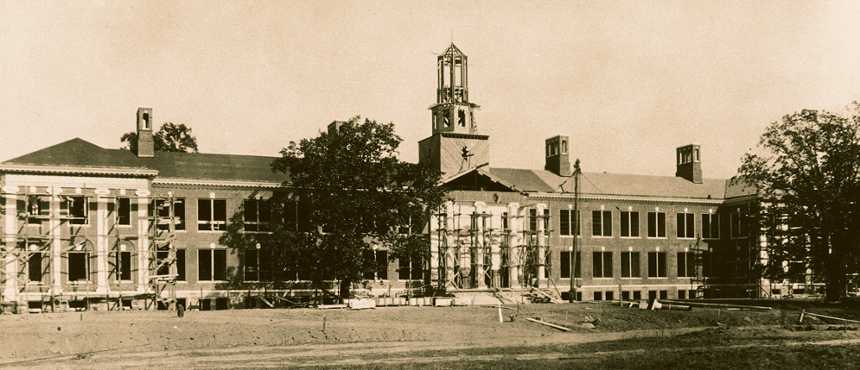History
History
History
The history of the College of Education mirrors the history of Rowan University (formerly Glassboro State College). Since its founding in 1923, Rowan University has undergone a transformation from a normal school to a comprehensive institution. Likewise, the College of Education has undergone a significant transformation from a Department of Education to its present structure as a complex College of Education. The University was founded to respond to a critical need in the educational system of the State of New Jersey: a lack of properly trained elementary school teachers. Consequently, Glassboro, New Jersey was chosen as the site to develop a "normal school" in Southern New Jersey. On September 24, 1923, Glassboro Normal School opened its doors to 236 young women. In 1934, Dr. Jerohn Savitz, the College's first president (1923-37), expanded the curriculum to four years and, in 1937, the school's name changed to New Jersey State Teachers College at Glassboro. Still, the sole purpose of the College was to educate and train elementary school teachers.
As early as 1937, the College had requested approval to establish a secondary school curriculum; it wasn't until 1947 that a "secondary school" curriculum was approved (only for grades 5-9). It wasn't until 1956 that English and Social Studies education was approved for the training of teachers for grades 7 through 12. In 1958, Art and Music were added to the program and, in 1960, Science and Mathematics education were added. Thus, it wasn't until 1960 that the School offered a full-blown secondary education training program for grades 7-12.
Although, as early as 1938, the College had a Graduate Cooperative Program in Education (with New York University), it wasn't until October 11, 1949 that the State Board of Education approved graduate courses to be offered on campus. As of 1996, the largest number of graduate courses offered by Rowan is in professional education. The University offers 25 graduate programs in addition to several certification programs. Out of the 25 graduate programs, 21 are offered by the College of Education.
The number of students taking professional education has increased significantly over the years (from 236 in 1923 to 1,740 undergraduate and 1,321 graduate students in 1995-96). We also served 297 post-baccalaureate students in elementary, secondary, special education and health and physical education in 1995-96. These students were enrolled in 19 undergraduate and 21 graduate programs. We offer B.A, M.A., and M.S.T. degrees, and an Ed.D. in Educational Leadership was approved at the state level on February 21, 1997.
As stated above, the history of the University and the development of the College of Education are intertwined. For many years, professional (methods) courses were offered by the Department of Education. Under the administration of the College's fourth president, Dr. Mark Chamberlain (1969-84), many new majors were developed. The new additions were a function of a law passed in 1966 that moved the administration of the state teacher colleges from the New Jersey Department of Education to the New Jersey Department of Higher Education. Along with this change, was the introduction of Liberal Arts programs (1966). As such, the four academic divisions of the College grew into the Schools of Business Administration, Fine and Performing Arts, Liberal Arts and Sciences, and Professional Studies. It should be noted that the legislation in 1966 created "Liberal Arts Colleges with a heavy professional education thrust." Thus, the College became a liberal arts school that was dedicated to professional education. In the 1972 catalog, the education courses were offered by the Division of Professional Studies. By 1985, the division had changed to the School of Professional Studies. In 1988, the School's name was changed to the School of Education and Related Professional Studies; and in 1995, to better reflect our programs and offerings, the School's name was changed to that of the School of Education. Subsequently after receiving University status in 1997, the Board of Trustees approved another name change for all academic units, and we became the College of Education.
Along with name changes and structural changes, the curricula offered changed. We moved from a singular elementary education program to multi-faceted offerings in elementary education, secondary education, special education, health and physical education, reading, and educational leadership.
The programs in the College of Education are constantly being upgraded in order for us to remain at the pinnacle of the professional field. In 1987, for example, the State of New Jersey offered Challenge Grants to the various institutions of higher education in the state. The College received such a grant. A million and a half dollars was given to the College of Education over three years to review and change its teacher preparation programs. We took three years revising the curricula to reflect the growing knowledge base in teacher education that was developing nationally. In addition, we focused on liberalizing professional education. As part of the grant, the College of Education established a unit to support first and second year teachers known as the Thomas E. Robinson Beginning Teacher Induction Center. In 1991, the College established its first Professional Development School in Camden, New Jersey. We now have three PDS's at the elementary level (in Camden and Woodbury, New Jersey), and have also established a PDS at the secondary level in Camden.
As a result of the 1992 $100,000,000 gift from industrialist, Henry Rowan, the name was changed to Rowan College of New Jersey. This institution achieved university status on March 21, 1997. The College of Education faculty and students are very proud of this distinction. We will continue to offer quality programs at the cutting edge of the preparation of education professionals.
